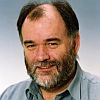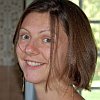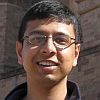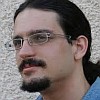| |
  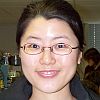
Stefan Grünewald,
Katharina Huber and
Qiong Wu. Two novel closure rules for constructing phylogenetic super-networks. In BMB, Vol. 70(7):1906-1924, 2008.
Keywords: abstract network, from splits, from unrooted trees, phylogenetic network, phylogeny, Program MY CLOSURE, reconstruction, supernetwork.
Note: http://arxiv.org/abs/0709.0283, slides available at http://www.newton.cam.ac.uk/webseminars/pg+ws/2007/plg/plgw01/0904/huber/.
Toggle abstract
"A contemporary and fundamental problem faced by many evolutionary biologists is how to puzzle together a collection P of partial trees (leaf-labeled trees whose leaves are bijectively labeled by species or, more generally, taxa, each supported by, e.g., a gene) into an overall parental structure that displays all trees in P. This already difficult problem is complicated by the fact that the trees in P regularly support conflicting phylogenetic relationships and are not on the same but only overlapping taxa sets. A desirable requirement on the sought after parental structure, therefore, is that it can accommodate the observed conflicts. Phylogenetic networks are a popular tool capable of doing precisely this. However, not much is known about how to construct such networks from partial trees, a notable exception being the Z-closure super-network approach, which is based on the Z-closure rule, and the Q-imputation approach. Although attractive approaches, they both suffer from the fact that the generated networks tend to be multidimensional making it necessary to apply some kind of filter to reduce their complexity. To avoid having to resort to a filter, we follow a different line of attack in this paper and develop closure rules for generating circular phylogenetic networks which have the attractive property that they can be represented in the plane. In particular, we introduce the novel Y-(closure) rule and show that this rule on its own or in combination with one of Meacham's closure rules (which we call the M-rule) has some very desirable theoretical properties. In addition, we present a case study based on Rivera et al. "ring of life" to explore the reconstructive power of the M- and Y-rule and also reanalyze an Arabidopsis thaliana data set. © 2008 Society for Mathematical Biology."
|
|
| |
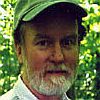   
James B. Whitfield,
Sydney A. Cameron,
Daniel H. Huson and
Mike Steel. Filtered Z-Closure Supernetworks for Extracting and Visualizing Recurrent Signal from Incongruent Gene Trees. In Systematic Biology, Vol. 57(6):939-947, 2008.
Keywords: abstract network, from unrooted trees, phylogenetic network, phylogeny, Program SplitsTree, split, split network, supernetwork.
Note: http://www.life.uiuc.edu/scameron/pdfs/Filtered%20Z-closure%20SystBiol.pdf.
|
|
| |

Tobias Kloepper. Algorithms for the Calculation and Visualisation of Phylogenetic Networks. PhD thesis, Eberhard-Karls-Universität Tübingen, Germany, 2008.
Keywords: from rooted trees, from sequences, from unrooted trees, galled network, phylogenetic network, phylogeny, Program SplitsTree, reconstruction, split network, visualization.
Note: https://publikationen.uni-tuebingen.de/xmlui/handle/10900/49159.
|
|
| |
  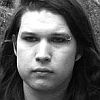 
Stefan Grünewald,
Andreas Spillner,
Kristoffer Forslund and
Vincent Moulton. Constructing Phylogenetic Supernetworks from Quartets. In WABI08, Vol. 5251:284-295 of LNCS, springer, 2008.
Keywords: abstract network, from quartets, from unrooted trees, phylogenetic network, phylogeny, Program QNet, Program SplitsTree, reconstruction, split network.
Note: http://dx.doi.org/10.1007/978-3-540-87361-7_24.
Toggle abstract
"In phylogenetics it is common practice to summarize collections of partial phylogenetic trees in the form of supertrees. Recently it has been proposed to construct phylogenetic supernetworks as an alternative to supertrees as these allow the representation of conflicting information in the trees, information that may not be representable in a single tree. Here we introduce SuperQ, a new method for constructing such supernetworks. It works by breaking the input trees into quartet trees, and stitching together the resulting set to form a network. The stitching process is performed using an adaptation of the QNet method for phylogenetic network reconstruction. In addition to presenting the new method, we illustrate the applicability of SuperQ to three data sets and discuss future directions for testing and development. © 2008 Springer-Verlag Berlin Heidelberg."
|
|
| |
   
Barbara R. Holland,
Steffi Benthin,
Peter J. Lockhart,
Vincent Moulton and
Katharina Huber. Using supernetworks to distinguish hybridization from lineage-sorting. In BMCEB, Vol. 8(202), 2008.
Keywords: explicit network, from unrooted trees, hybridization, lineage sorting, phylogenetic network, phylogeny, reconstruction, supernetwork.
Note: http://dx.doi.org/10.1186/1471-2148-8-202.
Toggle abstract
"Background. A simple and widely used approach for detecting hybridization in phylogenies is to reconstruct gene trees from independent gene loci, and to look for gene tree incongruence. However, this approach may be confounded by factors such as poor taxon-sampling and/or incomplete lineage-sorting. Results. Using coalescent simulations, we investigated the potential of supernetwork methods to differentiate between gene tree incongruence arising from taxon sampling and incomplete lineage-sorting as opposed to hybridization. For few hybridization events, a large number of independent loci, and well-sampled taxa across these loci, we found that it was possible to distinguish incomplete lineage-sorting from hybridization using the filtered Z-closure and Q-imputation supernetwork methods. Moreover, we found that the choice of supernetwork method was less important than the choice of filtering, and that count-based filtering was the most effective filtering technique. Conclusion. Filtered supernetworks provide a tool for detecting and identifying hybridization events in phylogenies, a tool that should become increasingly useful in light of current genome sequencing initiatives and the ease with which large numbers of independent gene loci can be determined using new generation sequencing technologies. © 2008 Holland et al; licensee BioMed Central Ltd."
|
|
| |
|
|
 - forked on GitHub.
- forked on GitHub.







